United States

Henry Ford Biography
Ford Motor Company Founder
Henry Ford, founder of Ford Motor Company, was born in Springwells Township, Wayne County, Michigan, on July 30, 1863, to Mary (Litogot) and William Ford. He was the eldest of six children in a family of four boys and two girls. His father was a native of County Cork, Ireland, who came to America in 1847 and settled on a farm in Wayne County.
Young Henry Ford showed an early interest in mechanics. By the time he was 12, he was spending most of his spare time in a small machine shop he had equipped himself. There, at 15, he constructed his first steam engine.
Later, he became a machinist’s apprentice in Detroit in the shops of James F. Flower and Brothers, and in the plant of the Detroit Dry Dock Company. After completing his apprenticeship in 1882, he spent a year setting up and repairing Westinghouse steam engines in southern Michigan. In July 1891, he was employed as an engineer at the Edison Illuminating Company of Detroit. He became chief engineer on November 6, 1893. Thomas Edison would become a lifelong mentor and friend to Henry Ford.
On April 11, 1888, Henry married Clara Jane Bryant of Greenfield, Michigan, the daughter of Martha (Bench) and Melvin Bryant, a Wayne County farmer. Clara lived to the age of 84 and died on September 29, 1950. They had one child, son Edsel Bryant Ford was born on November 6, 1893.
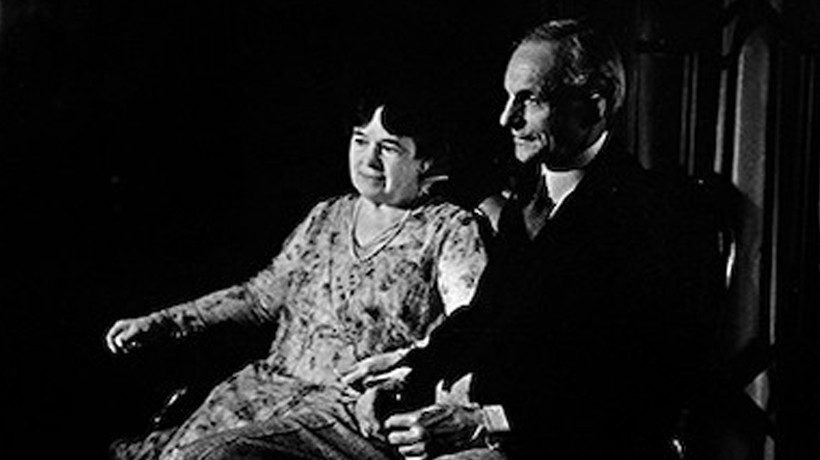
Henry Ford’s career as a builder of automobiles dated from the winter of 1893 when his interest in internal combustion engines led him to construct a small one-cylinder gasoline model. The first Ford engine sputtered its way to life on a wooden table in the kitchen of the Ford home at 58 Bagley Avenue in Detroit. A later version of that engine powered his first automobile, which was essentially a frame fitted with four bicycle wheels. This first Ford car, the Quadricycle, was completed in June 1896.
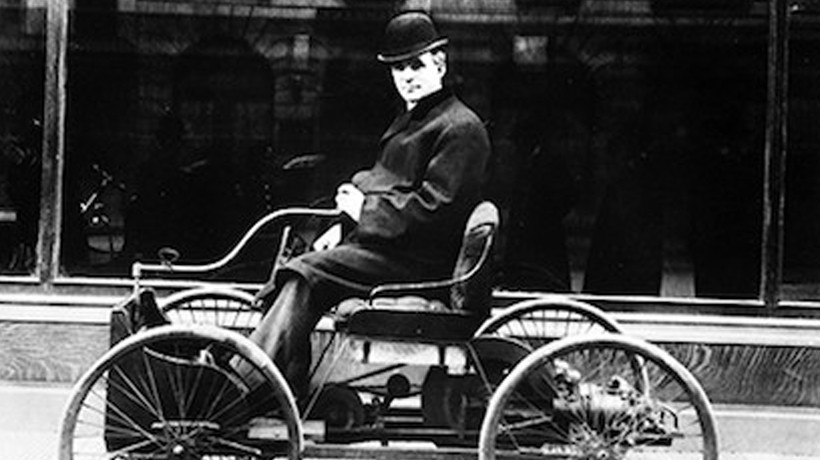
On August 19, 1899, he resigned from the Edison Illuminating Company and, with others, organized the Detroit Automobile Company, which went into bankruptcy about 18 months later. Meanwhile, Henry Ford designed and built several racing cars. In one of them, called Sweepstakes, he defeated Alexander Winton on a track in Grosse Pointe, Michigan on October 10, 1901. One month later, Henry Ford founded his second automobile venture, the Henry Ford Company. He would leave that enterprise, which would become the Cadillac Motor Car Company, in early 1902. In another of his racing cars, the 999, he established a world record for the mile, covering the distance in 39.4 seconds on January 12, 1904 on the winter ice of Lake St. Clair.
On June 16, 1903, Henry and 12 others invested $28,000 and created Ford Motor Company. The first car built by the Company was sold July 15, 1903. Henry owned 25.5% of the stock in the new organization. He became president and controlling owner in 1906. In 1919, Henry, Clara, and Edsel Ford acquired the interest of all minority stockholders for $105,820,894 and became the sole owners of the Company. Edsel, who succeeded his father as president in 1919, occupied that position until his death in 1943, when Henry Ford returned to the post.
In September, 1945, when he resigned the presidency for a second time, Henry Ford recommended that his grandson, Henry Ford II, be elected to the position. The board of directors followed his recommendation.
In 1946, Henry Ford was lauded at the Automotive Golden Jubilee for his contributions to the automotive industry. In July of that same year, 50,000 people cheered for him in Dearborn at a giant 83rd birthday party. Later that year, the American Petroleum Institute awarded him its first Gold Medal annual award for outstanding contributions to the welfare of humanity. The United States government honored him in 1965 by featuring his likeness with a Model T on a postage stamp as part of their Prominent Americans series. In 1999, Fortune magazine named Henry Ford the Businessman of the Century.
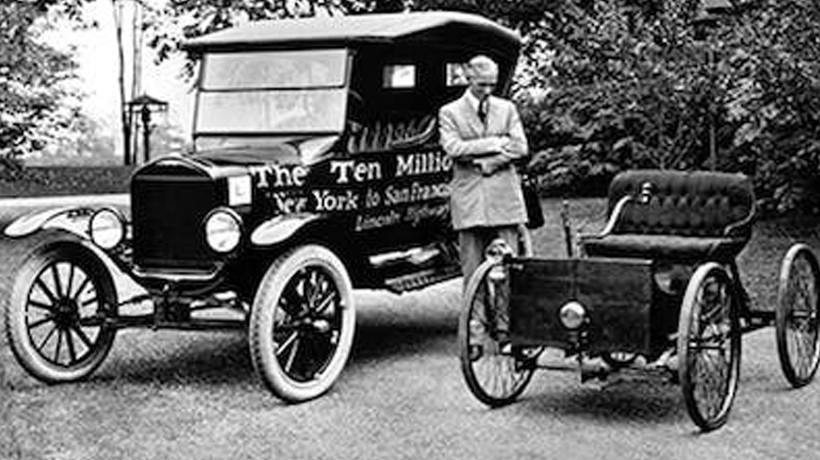
In collaboration with Samuel Crowther, he wrote My Life and Work (1922), Today and Tomorrow (1926), and Moving Forward (1930), which described the development of Ford Motor Company and outlined his industrial and social theories. He also published Edison, As I Know Him (1930), with the same collaborator. Doctor of Engineering degrees were conferred on him by the University of Michigan and Michigan State College (now Michigan State University), and he received an honorary Doctor of Law degree from Colgate University.
Henry Ford died at his residence, Fair Lane Estate in Dearborn, at 11:40pm on Monday, April 7, 1947, following a cerebral hemorrhage. He was 83 years old. At his bedside were Clara Ford and members of their household staff. At the time of his death, flooding on the Rouge River, which flows through the grounds of Fair Lane, had cut off electrical power. Old-fashioned kerosene lamps and candles were the only sources of light in the house, creating a scene similar to his birth in the same county many years before.
Funeral services were held at St. Paul’s Episcopal Cathedral in Detroit, Michigan, and Henry Ford was laid to rest in the family cemetery at St. Martha’s Episcopal Church, in Detroit.
Discover More
You may also like.

A Century of Tailgate Innovation

Women of Ford Part 3: 1990s-2020s
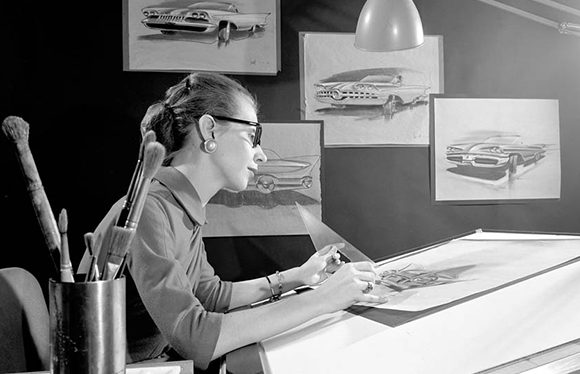
Women of Ford Part 2: 1950s-1980s
- History Classics
- Your Profile
- Find History on Facebook (Opens in a new window)
- Find History on Twitter (Opens in a new window)
- Find History on YouTube (Opens in a new window)
- Find History on Instagram (Opens in a new window)
- Find History on TikTok (Opens in a new window)
- This Day In History
- History Podcasts
- History Vault
By: History.com Editors
Updated: March 26, 2020 | Original: November 9, 2009

While working as an engineer for the Edison Illuminating Company in Detroit, Henry Ford (1863-1947) built his first gasoline-powered horseless carriage, the Quadricycle, in the shed behind his home. In 1903, he established the Ford Motor Company, and five years later the company rolled out the first Model T. In order to meet overwhelming demand for the revolutionary vehicle, Ford introduced revolutionary new mass-production methods, including large production plants, the use of standardized, interchangeable parts and, in 1913, the world’s first moving assembly line for cars. Enormously influential in the industrial world, Ford was also outspoken in the political realm. Ford drew controversy for his pacifist stance during the early years of World War I and earned widespread criticism for his anti-Semitic views and writings.
Henry Ford: Early Life & Engineering Career

Born in 1863, Henry Ford was the first surviving son of William and Mary Ford, who owned a prosperous farm in Dearborn, Michigan. At 16, he left home for the nearby city of Detroit, where he found apprentice work as a machinist. He returned to Dearborn and work on the family farm after three years, but continued to operate and service steam engines and work occasional stints in Detroit factories. In 1888, he married Clara Bryant, who had grown up on a nearby farm.
Did you know? The mass production techniques Henry Ford championed eventually allowed Ford Motor Company to turn out one Model T every 24 seconds.
In the first several years of their marriage, Ford supported himself and his new wife by running a sawmill. In 1891, he returned with Clara to Detroit, where he was hired as an engineer for the Edison Illuminating Company. Rising quickly through the ranks, he was promoted to chief engineer two years later. Around the same time, Clara gave birth to the couple’s only son, Edsel Bryant Ford. On call 24 hours a day for his job at Edison, Ford spent his irregular hours on his efforts to build a gasoline-powered horseless carriage, or automobile. In 1896, he completed what he called the “Quadricycle,” which consisted of a light metal frame fitted with four bicycle wheels and powered by a two-cylinder, four-horsepower gasoline engine.
Henry Ford: Birth of Ford Motor Company and the Model T
Determined to improve upon his prototype, Ford sold the Quadricycle in order to continue building other vehicles. He received backing from various investors over the next seven years, some of whom formed the Detroit Automobile Company (later the Henry Ford Company) in 1899. His partners, eager to put a passenger car on the market, grew frustrated with Ford’s constant need to improve, and Ford left his namesake company in 1902. (After his departure, it was reorganized as the Cadillac Motor Car Company.) The following year, Ford established the Ford Motor Company.
A month after the Ford Motor Company was established, the first Ford car—the two-cylinder, eight-horsepower Model A—was assembled at a plant on Mack Avenue in Detroit. At the time, only a few cars were assembled per day, and groups of two or three workers built them by hand from parts that were ordered from other companies. Ford was dedicated to the production of an efficient and reliable automobile that would be affordable for everyone; the result was the Model T , which made its debut in October 1908.
Henry Ford: Production & Labor Innovations
The “Tin Lizzie,” as the Model T was known, was an immediate success, and Ford soon had more orders than the company could satisfy. As a result, he put into practice techniques of mass production that would revolutionize American industry, including the use of large production plants; standardized, interchangeable parts; and the moving assembly line. Mass production significantly cut down on the time required to produce an automobile, which allowed costs to stay low. In 1914, Ford also increased the daily wage for an eight-hour day for his workers to $5 (up from $2.34 for nine hours), setting a standard for the industry.
Even as production went up, demand for the Tin Lizzie remained high, and by 1918, half of all cars in America were Model Ts. In 1919, Ford named his son Edsel as president of Ford Motor Company, but he retained full control of the company’s operations. After a court battle with his stockholders, led by brothers Horace and John Dodge, Henry Ford bought out all minority stockholders by 1920. In 1927, Ford moved production to a massive industrial complex he had built along the banks of the River Rouge in Dearborn, Michigan. The plant included a glass factory, steel mill, assembly line and all other necessary components of automotive production. That same year, Ford ceased production of the Model T, and introduced the new Model A, which featured better horsepower and brakes, among other improvements. By that time, the company had produced some 15 million Model Ts, and Ford Motor Company was the largest automotive manufacturer in the world. Ford opened plants and operations throughout the world.
Henry Ford: Later Career & Controversial Views
The Model A proved to be a relative disappointment, and was outsold by both Chevrolet (made by General Motors) and Plymouth (made by Chrysler); it was discontinued in 1931. In 1932, Ford introduced the first V-8 engine, but by 1936 the company had dropped to number three in sales in the automotive industry. Despite his progressive policies regarding the minimum wage, Ford waged a long battle against unionization of labor, refusing to come to terms with the United Automobile Workers (UAW) even after his competitors did so. In 1937, Ford security staff clashed with UAW organizers in the so-called “Battle of the Overpass,” at the Rouge plant, after which the National Labor Relations Board ordered Ford to stop interfering with union organization. Ford Motor Company signed its first contract with UAW in 1941, but not before Henry Ford considered shutting down the company to avoid it.
Ford’s political views earned him widespread criticism over the years, beginning with his campaign against U.S. involvement in World War I . He made a failed bid for a U.S. Senate seat in 1918, narrowly losing in a campaign marked by personal attacks from his opponent. In the Dearborn Independent, a local newspaper he bought in 1918, Ford published a number of anti-Semitic writings that were collected and published as a four volume set called The International Jew. Though he later renounced the writings and sold the paper, he expressed admiration for Adolf Hitler and Germany, and in 1938 accepted the Grand Cross of the German Eagle, the Nazi regime’s highest medal for a foreigner.
Edsel Ford died in 1943, and Henry Ford returned to the presidency of Ford Motor Company briefly before handing it over to his grandson, Henry Ford II, in 1945. He died two years later at his Dearborn home, at the age of 83.

HISTORY Vault: The Cars That Made America
Explore the stories of the visionaries who built America’s vehicle landscape.

Sign up for Inside History
Get HISTORY’s most fascinating stories delivered to your inbox three times a week.
By submitting your information, you agree to receive emails from HISTORY and A+E Networks. You can opt out at any time. You must be 16 years or older and a resident of the United States.
More details : Privacy Notice | Terms of Use | Contact Us
Henry Ford was an industrialist who revolutionized assembly line production for the automobile, making the Model T one of America’s greatest inventions.
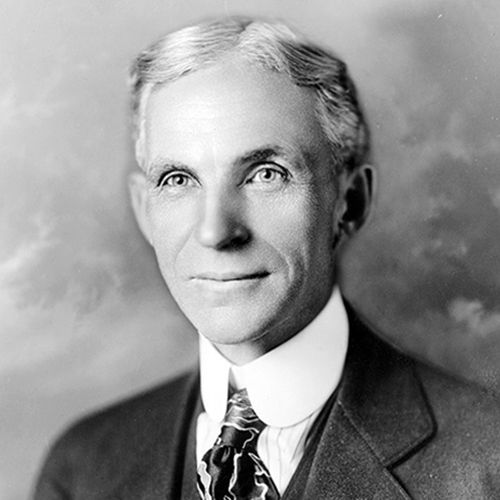
(1863-1947)
Who Was Henry Ford?
Henry Ford was an American automobile manufacturer who created the Model T in 1908 and went on to develop the assembly line mode of production, which revolutionized the automotive industry.
As a result, Ford sold millions of cars and became a world-famous business leader. The company later lost its market dominance but had a lasting impact on other technological development, on labor issues and on U.S. infrastructure. Today, Ford is credited for helping to build America's economy during the nation's vulnerable early years and is considered one of America's leading businessmen.
Early Life and Education
Ford was born on July 30, 1863, on his family's farm in Wayne County, near Dearborn, Michigan.
When Ford was 13 years old, his father gifted him a pocket watch, which the young boy promptly took apart and reassembled. Friends and neighbors were impressed and requested that he fix their timepieces too.
Unsatisfied with farm work, Ford left home at the age of 16 to take an apprenticeship as a machinist at a shipbuilding firm in Detroit. In the years that followed, he would learn to skillfully operate and service steam engines and would also study bookkeeping.
In 1888, Ford married Clara Ala Bryant. The couple had a son, Edsel, in 1893.
In 1890, Ford was hired as an engineer for the Detroit Edison Company. In 1893, his natural talents earned him a promotion to chief engineer.
All the while, Ford developed his plans for a horseless carriage. In 1892, Ford built his first gasoline-powered buggy, which had a two-cylinder, four-horsepower engine. In 1896, he constructed his first model car, the Ford Quadricycle.
In the same year, he attended a meeting with Edison executives and found himself presenting his automobile plans to Thomas Edison . The lighting genius encouraged Ford to build a second, better model.
DOWNLOAD BIOGRAPHY'S HENRY FORD FACT CARD
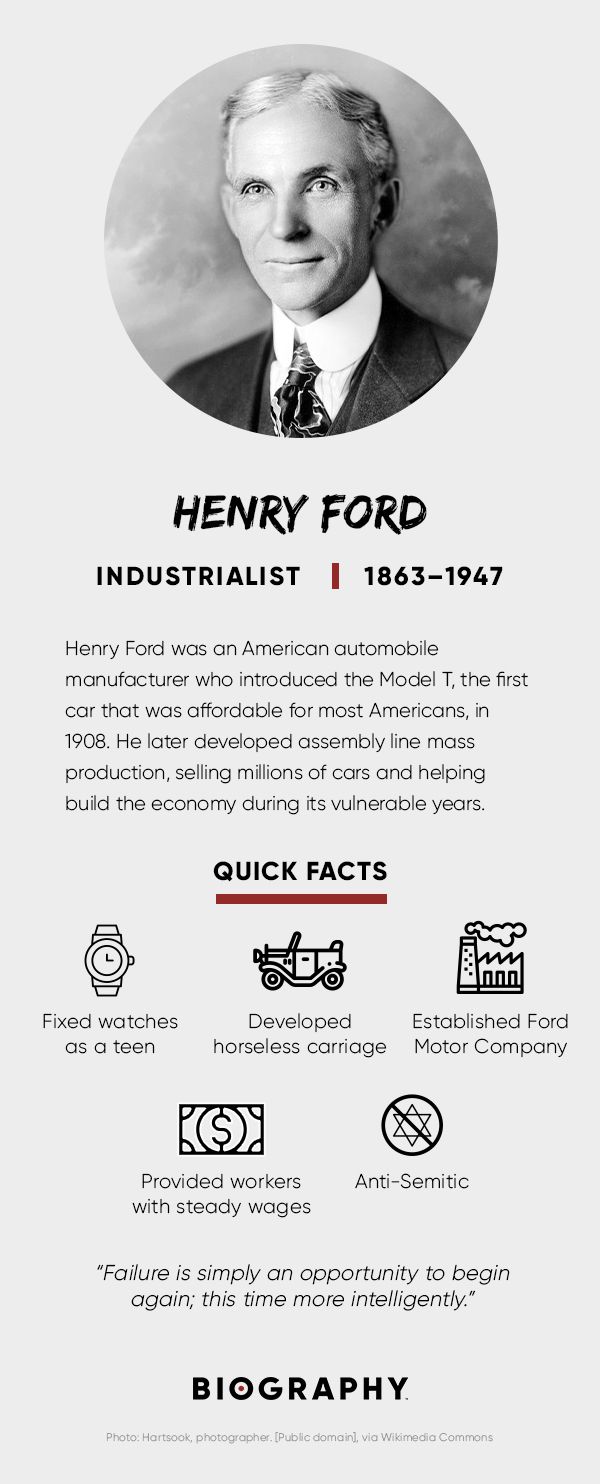
Ford Motor Company
By 1898, Ford was awarded with his first patent for a carburetor. In 1899, with money raised from investors following the development of a third model car, Ford left Edison Illuminating Company to pursue his car-making business full-time.
After a few trials building cars and companies, Ford established the Ford Motor Company in 1903.
Ford introduced the Model T , the first car to be affordable for most Americans, in October 1908 and continued its construction until 1927. Also known as the “Tin Lizzie,” the car was known for its durability and versatility, quickly making it a huge commercial success.
For several years, Ford Motor Company posted 100 percent gains. Simple to drive and cheap to repair, especially following Ford’s invention of the assembly line, nearly half of all cars in America in 1918 were Model T's.
By 1927, Ford and his son Edsel introduced another successful car, the Model A, and the Ford Motor Company grew into an industrial behemoth.
Henry Ford's Assembly Line
In 1913, Ford launched the first moving assembly line for the mass production of the automobile. This new technique decreased the amount of time it took to build a car from 12 hours to two and a half, which in turn lowered the cost of the Model T from $850 in 1908 to $310 by 1926 for a much-improved model.
In 1914, Ford introduced the $5 wage for an eight-hour workday ($110 in 2011), more than double what workers were previously making on average, as a method of keeping the best workers loyal to his company.
More than for his profits, Ford became renowned for his revolutionary vision: the manufacture of an inexpensive automobile made by skilled workers who earn steady wages and enjoyed a five-day, 40-hour work week.

Philosophy and Philanthropy
Ford was an ardent pacifist and opposed World War I , even funding a peace ship to Europe. Later, in 1936, Ford and his family established the Ford Foundation to provide ongoing grants for research, education and development.
In business, Ford offered profit sharing to select employees who stayed with the company for six months and, most important, who conducted their lives in a respectable manner.
At the same time, the company's "Social Department" looked into an employee’s drinking, gambling and otherwise uncouth activities to determine eligibility for participation.
Henry Ford, Anti-Semite
Despite Ford’s philanthropic leanings, he was a committed anti-Semite. He even went as far as to support a weekly newspaper, The Dearborn Independent , which furthered such views.
Ford published a number of anti-Semitic pamphlets, including a 1921 pamphlet, "The International Jew: The World's Foremost Problem.” Ford was awarded the Grand Cross of the German Eagle, the most important award Nazis gave to foreigners, by Adolf Hitler in 1938.
In 1998, a lawsuit filed in Newark, New Jersey, accused the Ford Motor Company of profiting from the forced labor of thousands of people at one of its truck factories in Cologne, Germany during World War II . The Ford company, in turn, said the factory was under the control of the Nazis, not the American corporate headquarters.
In 2001, Ford Motor Company released a study which found that the company did not profit from the German subsidiary, at the same time promising to donate $4 million to human rights studies focused on slavery and forced labor.
Ford died on April 7, 1947, of a cerebral hemorrhage at the age of 83, near his Dearborn estate, Fair Lane.
Henry Ford Museum
Ford was an avid collector of Americana, with a particular interest in technological innovations and the lives of ordinary people: farmers, factory workers, shopkeepers and business people. He decided to create a place where their lives and interests could be celebrated.
Opening in 1933, the Henry Ford Museum in Dearborn, Michigan, displays the thousands of objects Ford collected and many more-recent additions, such as clocks and watches, an Oscar Mayer Wienermobile, presidential limousines and other exhibits.
Also on display in the expansive outdoor Greenfield Village are operational railroad roundhouses and engines, the Wright Brothers bicycle shop, a replica of Thomas Edison's Menlo Park laboratory and Ford's relocated birthplace.
Ford's vision for the museum was stated as, "When we are through, we shall have reproduced American life as lived; and that, I think, is the best way of preserving at least a part of our history and tradition."
Thomas Edison
"],["
Adolf Hitler
"]]" tml-render-layout="inline">
QUICK FACTS
- Name: Henry Ford
- Birth Year: 1863
- Birth date: July 30, 1863
- Birth State: Michigan
- Birth City: Wayne County
- Birth Country: United States
- Gender: Male
- Best Known For: Henry Ford was an industrialist who revolutionized assembly line production for the automobile, making the Model T one of America’s greatest inventions.
- Business and Industry
- Astrological Sign: Leo
- Goldsmith, Bryant & Stratton Business College in Detroit
- Interesting Facts
- Upon Thomas Edison's blessing, Henry Ford sought to make a better car model and eventually started his own company.
- Ford became renowned for his revolutionary vision: the manufacture of an inexpensive automobile made by skilled workers who earn steady wages.
- Despite his pacifism and philanthropy, Ford was strongly anti-Semitic.
- Death Year: 1947
- Death date: April 7, 1947
- Death State: Michigan
- Death City: Dearborn
- Death Country: United States
We strive for accuracy and fairness.If you see something that doesn't look right, contact us !
CITATION INFORMATION
- Article Title: Henry Ford Biography
- Author: Biography.com Editors
- Website Name: The Biography.com website
- Url: https://www.biography.com/business-leaders/henry-ford
- Access Date:
- Publisher: A&E; Television Networks
- Last Updated: September 5, 2019
- Original Published Date: April 3, 2014
- The only history that is worth a tinker's damn is the history we make today.
- Failure is simply an opportunity to begin again; this time more intelligently.
- The only real mistake is one from which we learn nothing.
- If I had asked people what they wanted, they would have said, 'Faster horses.'
- Enthusiasm is the yeast that makes your hopes shine to the stars.
- Vision without execution is just hallucination.
- A business that makes nothing but money is a poor business.
- You don't have to hold a position in order to be a leader.
- Quality means doing it right when no one is looking.
- Don't find fault, find a remedy.
- Whether you think you can, or you think you can't—you're right.

Philanthropists

Aaron Judge

Dolly Parton

Michael J. Fox

Alec Baldwin

Kate Middleton, Princess of Wales

Tyler Childers

Prince William

Michelle Obama

Oprah Winfrey
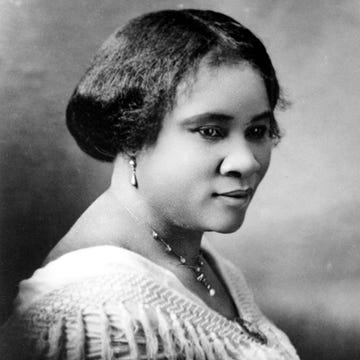
Madam C.J. Walker

Prince Harry

Jimmy Carter
- Humanities ›
- History & Culture ›
- Inventions ›
- Famous Inventors ›
Biography of Henry Ford, American Industrialist and Inventor
Bettmann / Getty Imges
- Famous Inventors
- Famous Inventions
- Patents & Trademarks
- Invention Timelines
- Computers & The Internet
- American History
- African American History
- African History
- Ancient History and Culture
- Asian History
- European History
- Latin American History
- Medieval & Renaissance History
- Military History
- The 20th Century
- Women's History
Henry Ford (July 30, 1863–April 7, 1947) was an American industrialist and business magnate best known for founding the Ford Motor Company and promoting the development of the assembly line technique of mass production. A prolific innovator and shrewd businessman, Ford was responsible for the Model T and Model A automobiles, as well as the popular Fordson farm tractor, the V8 engine, a submarine chaser, and the Ford Tri-Motor "Tin Goose" passenger airplane. No stranger to controversy, the often outspoken Ford was also known for promoting anti-Semitism .
Fast Facts: Henry Ford
- Known For: American industrialist, founder of the Ford Motor Company
- Born: July 30, 1863 in Dearborn, Michigan
- Parents: Mary Litogot Ahern Ford and William Ford
- Died: April 7, 1947 in Dearborn, Michigan
- Education: Goldsmith, Bryant & Stratton Business University 1888—1890
- Published Works: My Life and Work
- Spouse: Clara Jane Bryant
- Children: Edsel Ford (November 6, 1893–May 26, 1943)
- Notable Quote: “The only true test of values, either of men or of things, is that of their ability to make the world a better place in which to live.”
Henry Ford was born on July 30, 1863 to William Ford and Mary Litogot Ahern on the family’s farm near Dearborn, Michigan. He was the eldest of six children in a family of four boys and two girls. His father William was a native of County Cork, Ireland, who fled the Irish potato famine with two borrowed IR£ pounds and a set of carpentry tools to come to the United States in 1847. His mother Mary, the youngest child of Belgian immigrants, was born in Michigan. When Henry Ford was born, the United States was in the midst of the Civil War .
Ford completed first through eighth grades in two one-room schoolhouses, the Scottish Settlement School and the Miller School. The Scottish Settlement School building was eventually moved to Ford's Greenfield Village and opened to tourists. Ford was particularly devoted to his mother, and when she died in 1876, his father expected Henry to run the family farm. However, he hated farm work, later recalling, “I never had any particular love for the farm—it was the mother on the farm I loved.”
After the 1878 harvest, Ford abruptly left the farm, walking off without permission to Detroit, where he stayed with his father's sister Rebecca. He took a job at the streetcar manufacturer Michigan Car Company Works, but was fired after six days and had to return home.
In 1879, William got Henry an apprenticeship at the James Flower and Brothers Machine shop in Detroit, where he lasted nine months. He left that job for a position at the Detroit Dry Dock Company, which was a pioneer in iron ships and Bessemer steel. Neither job paid him enough to cover his rent, so he took a night job with a jeweler, cleaning and repairing watches.
Henry Ford returned to the farm in 1882, where he operated a small portable steam threshing machine—the Westinghouse Agricultural Engine—for a neighbor. He was very good at it, and over the summers of 1883 and 1884, he was hired by the company to operate and repair engines made and sold in Michigan and northern Ohio.
In December 1885, Ford met Clara Jane Bryant (1866–1950) at a New Year's Eve party and they married on April 11, 1888. The couple would have one son, Edsel Bryant Ford (1893–1943).
Ford continued to work the farm—his father gave him an acreage—but his heart was in tinkering. He clearly had a business in mind. Over the winters of 1888 through 1890, Henry Ford enrolled in Goldsmith, Bryant & Stratton Business University in Detroit, where he likely took penmanship, bookkeeping, mechanical drawing, and general business practices.
The Road to the Model T
By the early 1890s, Ford was convinced that he could construct a horseless carriage. He didn't know enough about electricity, however, so in September 1891 he took a job with the Edison Illuminating Company in Detroit. After his first and only son Edsel was born on November 6, 1893, Ford was promoted to chief engineer. By 1896, Ford had built his first working horseless carriage, which he named a quadricycle. He sold it in order to finance work on an improved model—a delivery wagon.
On April 17, 1897, Ford applied for a patent for a carburetor, and on August 5, 1899, the Detroit Automobile Company was formed. Ten days later, Ford quit the Edison Illuminating Company. And on January 12, 1900, the Detroit Automobile Company released the delivery wagon as its first commercial automobile, designed by Henry Ford.
Ford Motor Company and the Model T
Ford incorporated the Ford Motor Company in 1903, proclaiming, "I will build a car for the great multitude." In October 1908, he did so, as the first Model T rolled off the assembly line. Ford numbered his models by the letters of the alphabet, although not all of them made it to production. First priced at $950, the Model T eventually dipped as low as $280 during its 19 years of production. Nearly 15,000,000 were sold in the United States alone, a record that would stand for the next 45 years. The Model T heralded the beginning of the Motor Age. Ford's innovation was a car that evolved from a luxury item for the wealthy to an essential form of transportation for the “ordinary man,” which that ordinary man could afford and maintain by himself.
Thanks to Ford’s nationwide publicity effort, half of all cars in the United States were Model Ts by 1918. Every new Model T was black. In his autobiography, Ford famously wrote, “Any customer can have a car painted any color that he wants so long as it is black.”
Ford, who distrusted accountants, managed to amass one of the world's largest fortunes without ever having his company audited. Without an accounting department, Ford reportedly guessed how much money was being taken in and spent each month by separating the company's bills and invoices and weighing them on a scale. The company would continue to be privately-owned by the Ford family until 1956, when the first shares of Ford Motor Company stock were issued.
While Ford did not invent the assembly line , he championed it and used it to revolutionize manufacturing processes in the United States. By 1914, his Highland Park, Michigan, plant used innovative production techniques to turn out a complete chassis every 93 minutes. This was a stunning improvement over the earlier production time of 728 minutes. Using a constantly-moving assembly line, a subdivision of labor, and careful coordination of operations, Ford realized huge gains in productivity and personal wealth.
In 1914, Ford began paying his employees $5 a day, nearly doubling the wages offered by other manufacturers. He cut the workday from nine to eight hours in order to convert the factory to a three-shift workday. Ford's mass-production techniques would eventually allow for the manufacture of a Model T every 24 seconds. His innovations made him an international celebrity.
By 1926, faltering sales of the Model T finally convinced Ford a new model was needed. Even as production of the Ford Model T ended on May 27, 1927, Ford was working on its replacement, the Model A.
The Model A, the V8, and the Tri-Motor
In designing the Model A, Ford focused on the engine, chassis, and other mechanical necessities, while his son Edsel designed the body. With little formal training in mechanical engineering himself, Ford turned much of the actual design of the Model A to a talented team of engineers working under his direction and close supervision.
The first successful Ford Model A was introduced in December 1927. By the time production ended in 1931, more than 4 million Model As had rolled off the assembly line. It was at this point Ford decided to follow the marketing lead of his main competitor General Motors in presenting annual model enhancements as a means of boosting sales. During the 1930s, the Ford-owned Universal Credit Corporation became a major car-financing operation.
As the company’s design change for 1932, Ford set the auto industry on its ear with the revolutionary flathead Ford V8, the first low-price eight-cylinder engine. Variants of the flathead V8 would be used in Ford vehicles for 20 years, with its power and dependability leaving it an iconic engine among hot-rod builders and car collectors.
As a lifelong pacifist, Ford refused to produce arms for either world wars, but he did make engines suitable for aircraft, jeeps, and ambulances. Made by the Ford Airplane Company, the Ford Tri-Motor, or "Tin Goose," was the mainstay of the earliest airplane passenger service between the late 1920s and early 1930s. Even though only 199 were ever built, Ford's all-metal construction, 15-passenger capacity planes suited the needs of almost all of the early airlines until newer, larger, and faster planes from Boeing and Douglas became available.
Other Projects
Although best known for the Model T, Ford was a restless man and had a substantial number of side projects. One of his most successful was a farm tractor, called the Fordson, which he began developing in 1906. It was built on a Model B engine with a large water tank in place of a standard radiator. By 1916, he had built working prototypes, and when World War I started, he produced them internationally. The Fordson continued to be made in the U.S. until 1928; his factories in Cork, Ireland, and Dagenham, England, made Fordsons throughout World War II.
During World War I, he designed the "Eagle," a submarine chaser powered by a steam turbine. It carried an advanced submarine detection device. Sixty were put into service by 1919, but the costs of development were much higher than original estimates—for one thing, Ford had to excavate canals near his plants to test and transport the new ships.
Ford also built hydroelectric plants, eventually constructing 30 of them, including two for the U.S. government: one on the Hudson River near Troy, New York, and one on the Mississippi River at Minneapolis/St. Paul, Minnesota. He had a project called Ford Estates, in which he would buy up properties and rehab them for other purposes. In 1931, he bought the 18th-century manor Boreham House in Essex, England, and a surrounding 2,000 acres of land. He never lived there but set up Boreham House as an Institute of Agricultural Engineering to train men and women on new technologies. Another Ford Estates project was cooperative farming properties in several rural areas in the U.S. and U.K., where people lived in cottages and raised crops and animals.
After the Japanese attacked Pearl Harbor in 1941, Ford became one of the major U.S. military contractors, supplying airplanes, engines, jeeps, and tanks throughout World War II.
Later Career and Death
When Ford’s son Edsel, then president of Ford Motor Company, died of cancer in May 1943, the elderly and ailing Henry Ford decided to reassume the presidency. Now nearly 80 years old, Ford had already suffered several possible heart attacks or strokes, and was described as having become mentally unstable, unpredictable, suspicious, and generally no longer fit to lead the company. However, having had de facto control of the company for the last 20 years, Ford convinced the board of directors to elect him. With Ford serving until the end of World War II, Ford Motor Company declined sharply, losing more than $10 million a month—nearly $150 million today.
In September 1945, with his health failing, Ford retired and ceded the presidency of the company to his grandson, Henry Ford II. Henry Ford died at age 83 on April 7, 1947, of a cerebral hemorrhage at his Fair Lane estate in Dearborn, Michigan. More than 5,000 people per hour filed past his casket at a public viewing held at Greenfield Village. Funeral services were held in Detroit's Cathedral Church of St. Paul, after which Ford was buried in the Ford Cemetery in Detroit.
Legacy and Controversy
Ford's affordable Model T irrevocably altered American society. As more Americans owned cars, urbanization patterns changed. The United States saw the growth of suburbia, the creation of a national highway system, and a population entranced with the possibility of going anywhere anytime. Ford witnessed many of these changes during his lifetime, all the while personally longing for the agrarian lifestyle of his youth.
Unfortunately, Ford was also criticized as an anti-Semite. In 1918, Ford purchased a then-obscure weekly newspaper called The Dearborn Independent, in which he regularly expressed his strongly anti-Semitic views. Ford required all of his auto dealerships nationwide to carry the Independent and distribute it to its customers. Ford's anti-Semitic articles were also published in Germany, prompting Nazi Party leader Heinrich Himmler to describe him as “one of our most valuable, important, and witty fighters.”
In Ford’s defense, however, his Ford Motor Company was one of the few major corporations known for actively hiring Black workers during the early 1900s, and was never accused of discriminating against Jewish workers. In addition, Ford was among the first companies of the day to regularly hire women and handicapped persons.
Sources and Further References
- Bryan, Ford Richardson. "Beyond the Model T: The Other Ventures of Henry Ford." 2nd ed. Detroit: Wayne State University Press, 1997.
- Bryan, Ford R. "Clara: Mrs. Henry Ford.” Detroit: Wayne State University Press, 2013.
- Ford, Henry and Crowther, Samuel (1922). "My Life and Work." CreateSpace Independent Publishing Platform, 2014.
- Lewis, David L. "The Public Image of Henry Ford: An American Folk Hero and His Company." Detroit: Wayne State University Press, 1976.
- Swigger, Jessica. "History Is Bunk: Historical Memories at Henry Ford's Greenfield Village." University of Texas , 2008.
- Weiss, David A. "The Saga of the Tin Goose: The Story of the Ford Tri-Motor." 3rd ed. Trafford, 2013.
- Wik, Reynold M. "Henry Ford and Grass-roots America." Ann Arbor: The University of Michigan Press, 1973.
- Glock, Charles Y. and Quinley, Harold E. “Anti-Semitism in America.” Transaction Publishers, 1983.
- Allen, Michael Thad. “The Business of Genocide: The SS, Slave Labor, and the Concentration Camps.” University of North Carolina Press, 2002.
- Wood, John Cunningham and Michael C. Wood (eds). "Henry Ford: Critical Evaluations in Business and Management, Volume 1." London: Routledge, 2003.
Updated by Robert Longley .
- Henry Ford's Greatest Quotes
- Biography of Mary Anderson, Inventor of the Windshield Wiper
- History's 15 Most Famous Inventors
- Famous Automobile Makers
- Henry Blair - African American Inventor
- Black History Month - African American Inventors
- Biography of Samuel Colt, American Inventor and Industrialist
- Women Inventors A to Z
- Biography of George Pullman, Inventor of the Railroad Sleeping Car
- A Biography of Henry T. Sampson
- Biography of Thomas Newcomen, Inventor of the Steam Engine
- Biography of Cyrus Field
- Biography of Garrett Morgan, Inventor of the Gas Mask
- Biography of Humphry Davy, Prominent English Chemist
- Henry Brown - Inventor
- Biography of John Lee Love, Portable Pencil Sharpener Inventor

IMAGES
VIDEO
COMMENTS
Henry Ford, founder of Ford Motor Company, was born in Springwells Township, Wayne County, Michigan, on July 30, 1863, to Mary (Litogot) and William Ford. He was the eldest of six children in a family of four boys and two …
• In Aldous Huxley's Brave New World (1932), society is organized on "Fordist" lines, the years are dated A.F. or Anno Ford ("In the Year of Ford"), and the expression "My Ford" is used instead of "My Lord". The Christian cross is replaced with a capital "T" for Model-T.• Upton Sinclair created a fictional description of Ford in the 1937 novel The Flivver King.
Henry Ford established the Ford Motor Company in 1903, and five years later the company rolled out the first Model T. Ford introduced revolutionary new mass-production methods, including large...
Henry Ford was an American automobile manufacturer who created the Model T in 1908 and went on to develop the assembly line mode of production, which revolutionized the automotive...
Henry Ford (born July 30, 1863, Wayne county, Michigan, U.S.—died April 7, 1947, Dearborn, Michigan) was an American industrialist who revolutionized factory production with his assembly-line methods.
Henry Ford, the pioneering industrialist, transformed the automotive industry forever with his innovative production techniques, democratizing car ownership.
Henry Ford (July 30, 1863–April 7, 1947) was an American industrialist and business magnate best known for founding the Ford Motor Company and promoting the development of the assembly line technique of …
Henry Ford, American industrialist who revolutionized factory production with his assembly-line methods. He formed the Ford Motor Company in 1903 and was the creative force behind an industry of unprecedented size and wealth that would …